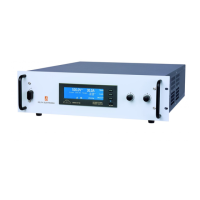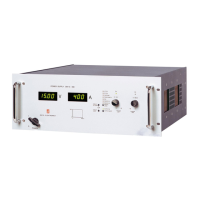Ethernet & Sequencer Programming SM15K
28 / 44 DELTA ELEKTRONIKA B.V. rev. Aug. 2019
CJL
CJL stands for Compare Jump if Less. Can be used in combination with Source / Measure Voltage /
Current / Power and the variables. CJL allows to create conditional jumps to any step within the sequence.
It compares the first two operands and branches if the first value is less than the second to the step
declared in the third operand.
Syntax: CJL<sp><SV>,<NR2>,<label>
CJL<sp><MV>,<NR2>,<label>
CJL<sp><SC>,<NR2>,<label>
CJL<sp><MC>,<NR2>,<label>
CJL<sp><SCN>,<NR2>,<label>
CJL<sp><SP>,<NR2>,<label>
CJL<sp><SPN>,<NR2>,<label>
CJL<sp><MP>,<NR2>,<label>
CJL<sp><#x>,<NR1>,<label> x = variable A,B,C,D,E,F,G,H,I or J
For example CJL<sp>SC,10,increase ; When the current setting is less than 10A, the program jumps to
step defined by the label define 'increase', otherwise it continues with the next step.
6.2.3 Arithmetic
INC
INC stands for Increment. Can be used in combination with Voltage, Current, Power and Variables.
Syntax : INC<sp><SV>,<NR2>
INC<sp><SC>,<NR2>
INC<sp><SCN>,<NR2>
INC<sp><SP>,<NR2>
INC<sp><SPN>,<NR2>
INC<sp><#x>,<NR1> x = A, B,C,D,E,F,G,H,I or J
DEC
DEC stands for Decrement. Can be used in combination with Voltage, Current, Power and Variables.
Syntax : DEC<sp><SV>,<NR2>
DEC<sp><SC>,<NR2>
DEC<sp><SCN>,<NR2>
DEC<sp><SP>,<NR2>
DEC<sp><SPN>,<NR2>
DEC<sp><#x>,<NR1> x = A, B,C,D,E,F,G,H,I or J
6.2.4 Miscellaneous
NOP
NOP stands for No Operation. No actions are done when a step contains this command.
This command can be used to arrange step numbers for future implementations or to create some small
delays between commands.
Syntax : NOP
W
W stands for Wait. Can be used to create an idle time. The operand declares the time (in seconds) the
program has to wait before it continues with the next step.
Syntax : W=<NR2> <NR2> = 0.001 ... 65535
TRG
TRG stands for Trigger. The program waits until a TRIGger:IMMediate command is received via TCP/IP.
After that it continues with the next step of the sequence. This command sets the "Wait For Trigger"-bit in
the Status:Register:B
Syntax : TRG
END
END stands for End of program. When the system reads this command, the program will stop. Every
program must have an END function included. (It's not necessary to have an END on the last step of the
sequence ; e.g. after an END the program can have subroutines).
Syntax : END
When a sequence without END function is executed the "Program Open End Error"-bit is set in the
Status:Register:B

